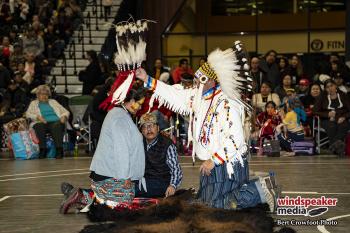Image Caption
Summary
Windspeaker.com Contributor
A headdress transfer ceremony held on Dec. 28 will guide Tsuut’ina Nation Minor Chief Corrine Eagletail as she makes decisions for her people.
“She earned the right when she got elected, but now she followed protocol to ignite the feather hat, the power within the feather hat,” said Travis Meguinis, who performed the transfer ceremony.
The ceremony included songs, dance, and paints. Eagletail was painted with yellow, symbolic of the sun, and red, symbolic of human beings. The paint is for good luck and protection, said Meguinis, and the final song, a post-victory song, was “for her to move forward in a good way.”
Eagletail was one of 12 people elected as councillor – or minor chief – in the November 2019 election. Roy Whitney-Onespot was elected as chief.
“The ceremony ignites—the power behind it, the essence. Anybody can put (a headdress) on, but there’s really no ceremony to go with it. But once you’ve had the ceremony, you need witnesses, too, that people can see she went through that, that she not only was given a feather hat, but she earned that right to wear it through ceremony,” said Meguinis, who along with Hal Eagletail made the headdress for Corrine. Both men have been given the right to work with eagle feathers.
The transfer ceremony was witnessed by Whitney-Onespot; past minor chiefs Kevin Littlelight (also a Sacred Horns Society member), Bruce Starlight and Ivan Eagletail; Hal Eagletail; and Clarence Wolfleg, who is past minor chief of Siksika Nation, member of the Sacred Horns’ Society and the Brave Dog Society and veteran of International Peace Keeping with the NATO and the United Nations. It is a belief that a war veteran should be included in every transfer ceremony.
Many people mistake the headdress transfer as a Blackfoot ceremony, says Meguinis, but the roots go much deeper than that. In fact, the ceremony dates back to Chief Sitting Bull, born in 1831 in what is now South Dakota. Sioux tribes united under his guidance, fighting in what became known as the Battle of Little Bighorn against General Armstrong Custer in eastern Montana in 1876.
As Meguinis tells it, Sitting Bull came to southern Alberta with a travois of flow-back headdresses.
“He had so many feather hats given to him for so many remarkable things he’d done for so many tribes. He came up and spent some time with us. They say two years he spent with us, and he was so thankful that he left the feather hats transfer ceremony with southern Alberta.
“They said that Sitting Bull had a dream. The reason why he left it here in southern Alberta was that he had a vision long ago that it was going to be symbolic for all of Turtle Island that the feather hat was going to be symbolic for leaders in the future. And it is.”
Before Sitting Bull visited southern Alberta, straight-up headdresses were traditional.
There is a protocol that comes with wearing flow-back headdress.
“Most people just put it on for looks. Right away it’s ego. The way I see it, when they get into leadership they just put it on symbolizing them being a leader. But really the whole meaning behind it is for protection and guidance because those eagle feathers come from the Grandfather Thunderbird, the eagle, he sits beside God Creator and that brings wisdom to us and that brings us protection and through that it helps guide us as leaders. Feather hats are very powerful in our way,” said Meguinis.
Feather hats aren’t only for chiefs, he adds, noting that elected councillors may also wear them. Feather hats may be given or earned.
“If you do great things and it’s heard and it’s echoed in all four directions and you make a big name for yourself that’s a good time to wear one, to have earned it… wanting to not just empower yourself, but to empower the people,” said Meguinis.
Meguinis earned a feather hat when he was in his late twenties by achieving two professional contracts in hockey, adoption into the Horn Society, and political leadership earned. His transfer ceremony occurred in the early 2000s, fittingly at the old Sarcee Seven Chiefs Arena in Tsuut’ina. Because he knew his traditional ways, he also earned the right to perform such ceremonies.
Eagletail’s headdress transfer marks the seventh ceremony carried out by Meguinis, since he did his first in 2007. Meguinis also performed headdress ceremonies for Prime Minister Justin Trudeau and Assembly of First Nations National Chief Perry Bellegarde in 2016 when they visited the Tsuut’ina Nation.

